Episodes
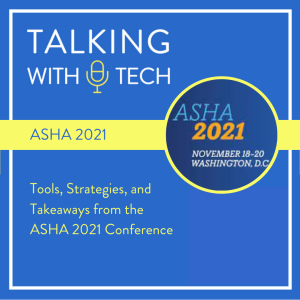
Wednesday Dec 08, 2021
Wednesday Dec 08, 2021
This week, Rachel and Chris discuss their recent trip to ASHA 2021 and some of their favorite takeaways that they will be using in their own practice, including why its better to present on a fewer number of tools with more information on how to use them, why you have to be both interesting and informative when presenting, how to make sessions more engaging so people will show up, and more!
Sessions Discussed this Week:
Shaun Sweeney - Play on Words: Thoughtful Uses of “Game-Based” Apps and Resources in Language-Based Interventions. Sean discussed excellent tools and strategies related to technology and shared engaging stories about his clinical practice. Often, it’s better to present on fewer tools but do a deeper dive into how to use the tools you presented on than to have a list of tools you touch on for a few minutes.
Chris Wenger, AKA The Speech Dude. Accelerate Progress for Students on IEPs with Cutting-Edge Tech Tools to Support Social Learning Challenges. Lean into things that are difficult. When there is a difficult IEP, don’t shy away from that. Take a growth mindset. How are we delivering content in an engaging way?
Rachel Dorsey, Hillary Crow, and Carolyn Gaddy - Neurodiversity as a Cultural Competency: Three Autistic SLPs Walk into an ASHA Convention. Super powerful session that really got Rachel thinking about what she is doing her own practice to embrace neurodiversity, including the language she uses when writing goals and when talking about Autism.
Jesse Ginsburg and Jake Greenspan - Effective Floortime Strategies for Increasing Attention & Engagement in ASD. One question to ask yourself when giving a task to a student - Who is doing the thinking - are they doing the thinking or are you? When you are directing the experience, it’s probably you.
Christina Royster, Jill D’Braunstein, Alma Partida - Integrating Diverse and Inclusive AAC. While they have added more diverse options for AAC systems, companies need to be making it easier for us to change symbols and dialects for the whole system at once.
Meredith Gohsman and Rachel Johnson - AAC Camp for Linguistic & Social Competencies: Child, Caregiver, and Student Outcomes. Research showed that after 9 sessions of AAC Camp, there was no change in the students receiving language instruction or the parents participating in sessions. The only change they saw was int he growth of the students who put the camp together. They thought they needed more time - either do the activities all year round, or hold multiple camps year after year.
Links:
Rachel and Chris have an upcoming pre-conference session at ATIA 2022 on Jan 26th from 8 am to 4 pm! Designing and Delivering Empowering Experiences to Teach language Using AAC!
ATIA Pre Conference - Jan 26 from 8 to 4. Learn more at https://www.atia.org/atia-2022-pre-conference-seminars/#AAC2
Help us develop new content and keep the podcast going strong! Support our podcast at patreon.com/talkingwithtech!
Visit talkingwithtech.org to access previous episodes, resources, and CEU credits that you can earn for listening to TWT episodes!
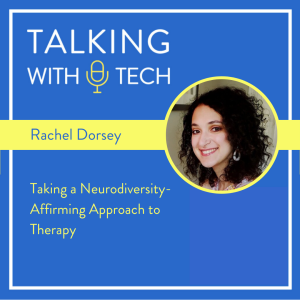
Thursday Dec 02, 2021
Thursday Dec 02, 2021
This week, Rachel interviews Rachel Dorsey, the amazing "Autistic SLP" who runs a private practice and teaches courses on Neurodiversity and Goal Writing. Rachel shares her perspective on neurodiversity, how to help shift the perspectives of others to better affirm neurodiversity, the importance of co-regulation for Autistic people, and more!
Before the interview, Rachel and Chris sit down with Melissa Bugaj and Sara Gregory to have a quick roundtable banter about gestalt language processing (e.g. scripting) vs analytical language processing, and ways that all people may use both methods to learn language.
Key ideas this week:
🔑 A “neurodiversty affirming approach to Autism” involves respecting everyones differences and seeing people through their strengths and not just their deficits. It Includes listening to people from that community to learn from them how to improve your affirming practices.
🔑 What can we do to help shift people’s perspective to better support neurodiversity? Rachel Dorsey says help these people to ask “why”. Why is this happening? Why are they being disruptive? Why did they go from not being able to do a skill to doing it? Is it environment? Then, shift what you do next time in response to what you learn.
🔑 "Co-regulating" can happen in therapy when both therapist and the student (or client) help each other regulate. This will look different for different people. Does the Autistic person like to be left alone to do their own thing? Do they enjoy physical presence, or do they want space? Co-regulation helps to build trust and rapport and may help improve progress in therapy down the road.
Use the code MADEL30 to get $30 off Rachel Dorsey’s course on Goal Writing for Autistic Students at Dorseyslp.com/courses

Sunday Nov 28, 2021
Sunday Nov 28, 2021
This week, Chris chats with Michaela Ball, TWT’s Audio Engineer & SLP Grad Student, about getting a certification in Assistive Technology while she finishes her Master’s degree. They have a lively discussion about why Chris thinks that the time and money spent on AT certification could be better spent on other kinds of professional development.
Before the interview, Chris and Rachel discuss a recent experience Chris had in a classroom of young students playing Minecraft, including using Immersive Reader to read text in the game and learning about coding while playing Minecraft.
Key Ideas This Week:
🔑 In many parts of the US, there are lots of SLP jobs available without needing a specific certification to get the job. AT jobs may or may not be more competitive depending on the area you work in.
🔑 People who choose to get certification have good reasons to do so, but getting a certification can be a large expenditure of time and money that could be spent more effectively in other ways.
🔑 RESNA certification could be useful in situations where professional competence is called into question or to improve your resume when looking for AT jobs. Chris has heard from RESNA-certified colleagues that their certification was not very useful in improving their day-to-day work as an AT professional.
Help us develop new content and keep the podcast going strong! Support our podcast at patreon.com/talkingwithtech!
Visit talkingwithtech.org to access previous episodes, resources, and CEU credits that you can earn for listening to TWT episodes!
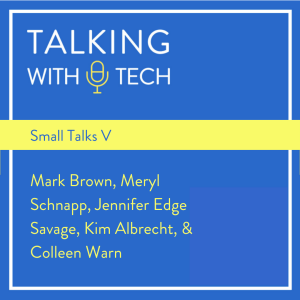
Wednesday Nov 17, 2021
Wednesday Nov 17, 2021
This week, we share five brief “small talks”, or short interviews, with Mark Brown, Meryl Schnapp, Jennifer Edge Savage, Kim Albrecht, & Colleen Warn!
Before the interviews, Chris and Rachel have an amazing discussion about targeting spontaneous language when people do not communicate much without a prompt or model. For example, you can help parents and teachers realize how much (or little) their child/student communicates spontaneously by having them track it during the day. Making sure to give appropriate wait time and finding something that is motivating are also essential to encouraging independent initiation.
Small Talks This Episode:
🗣️Mark Brown discusses 22q11.2 deletion syndrome, and how we can better support them through AAC during early language development. With 22q11.2 deletion syndrome, language is delayed and there can be cognition deficits. There can also be VP insufficiency which creates hypernasal resonance and impacts articulation and intelligibility. AAC can be used as an interim support before they are more intelligible.
🗣️Meryl Schnapp shares about using 3d printed tactile core symbols, and her efforts to create large classroom sized core board with tactile symbols that are always put in a consistent location, because it would be frustrating to dig through a basket of objects every time you wanted to say a word.
🗣️Jennifer Edge Savage talks about starting AAC Town Halls during the pandemic while working for northeast PRC-Saltillo. They had a lot of SLPs sharing resources with each other about things that were new or different during remote learning, like AAC tele-assessment.
🗣️Kim Albrecht talks about making her home the local “grand central station” for the neighborhood kids, which is really good exposure for her daughter Miranda.
🗣️Coleen Warn discusses working to create asynchronous learning experiences for people. They developed a bunch of screencasts that are only about 2-5 minutes long that cover different aspects of different AAC tools to encourage people to learn more about their devices.
Help us develop new content and keep the podcast going strong! Support our podcast at patreon.com/talkingwithtech!
Visit talkingwithtech.org to access previous episodes, resources, and CEU credits that you can earn for listening to TWT episodes!

Thursday Nov 11, 2021
Thursday Nov 11, 2021
This week on TWT, we are excited to present Rachel’s interview with the amazing Alexandria Zachos! Alexandria is an SLP, educator, and private practice owner who specializes in treating delayed echolalia (aka scripting) and using the Naturalistic Language Acquisition framework to move from echolalia to self-generated language. Alexandria has a wealth of information to share about gestalt language (learning language in chunks or scripts), how we can teach language to gestalt learners, and how to determine if someone is a Gestalt Language Processor.
Before the interview, Chris and Rachel share about a recent presentation at Closing the Gap, and their plans for a similar pre-conference session at ATIA on January 26th from 8 am to 4 pm. They discuss some of the plans they have to make the sessions fun and share some of what they have learned about putting together a meaningful presentation.
Key ideas this week:
🔑 There are two ways that people learn language - Gestalt Language Processors, who learn in chunks or scripts, versus Analytical Language Processors who learn one word, then learn to put two together, and so on.
🔑 Some GLP communicate with single words, but they can’t combine words together to make longer sentences. Others use longer scripts to communicate that are taken from things like favorite media. Other GLP sound unintelligible for a few syllables then say clear word - the unilntellgible sounds and the word together make up the gestalt.
🔑 Understand what stage of echolalia the child is at:
Echolalia - full scripts. Can be delayed (scripts are used long after the initial stimulus).
Mix and match - moving around partial scripts or taking parts of scripts.
Magic stage - starts to understand that words are units - singling out words and understanding they can stand alone.
Beginning grammar and novel original language.
Help them get as many gestalts as possible in Stage 1, then they can break them down in Stage 2 and get the to Stage 3 where they can single the words out.
Find out more about Alexandria’s work at www.meaningfulspeech.com or on Instagram @meaningfulspeech
Help us develop new content and keep the podcast going strong! Support our podcast at patreon.com/talkingwithtech!
Visit talkingwithtech.org to access previous episodes, resources, and CEU credits that you can earn for listening to TWT episodes!

Wednesday Nov 03, 2021
Wednesday Nov 03, 2021
This week, Rachel interviews Cindy Gelormini, parent of an autistic person and author of a series of children’s books about autism called "Robbie's World and his Spectrum of Adventures". Previously, Cindy built a following on YouTube making videos about her son and their life together. Cindy shares about her son’s journey as a communicator, and some of the challenges he faced not having a method of communication beyond PECS and gesture. Tragically, her son passed away, and Cindy discusses why she wanted to write and illustrate a series of books to carry on Robbie's memory and to help others understand autism a little bit better.
Before the interview, Rachel and Chris discuss their upcoming presentation on Coaching at ASHA 2021! They will be presenting together on November 19th, from 1:30 pm to 2:30 pm. Chris will also be presenting on gaming and communication on Saturday, 11/20 at 9:30 am, and presenting on robots and communication on 11/20 at 4:30 pm!
Key ideas this week:
🔑 Without a good foundation of communication, people can become much more frustrated and there can be more behaviors. In some cases, this frustration and stress may lead to other health problems.
🔑 If seizures are happening to a client or someone in your family, start tracking what happens before the seizure, what happens after the seizure, and what it looked like. This information can be very helpful down the road.
🔑 For some people, AAC is important because they know what they want to say, but the right words aren’t being articulated. For example, Rachel shares about a client that answered every preposition question with the verbal answer “under” but, when given an AAC device, was able to select the correct answer every time, indicating he knew the correct preposition even if he couldn’t say it.
Links:
Cindy's YouTube Page (includes episodes of her podcast and videos of Robbie): Robbie and Me: Autism Reality
Help us develop new content and keep the podcast going strong! Support our podcast at patreon.com/talkingwithtech!
Visit talkingwithtech.org to access previous episodes, resources, and CEU credits that you can earn for listening to TWT episodes!
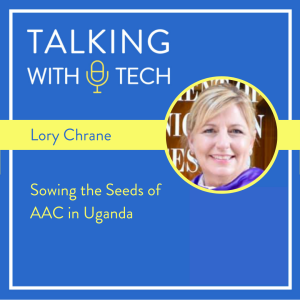
Wednesday Oct 27, 2021
Wednesday Oct 27, 2021
This week, Chris interviews Lory Chrane, an AAC Specialist and Professor at Abelene Christian University. Chris and Lory talk about how Lory has tried to improve pre-service teaching by involving as much experiential learning as possible, especially in the area of AAC instruction. Lory also describes a mission trip to Uganda to work with Hope Speaks, a nonprofit that supports people who have communication challenges and SLPs in Uganda.
Before the interview, Chris and Rachel connect to talk about slang and AAC, including the slang word “poggers" that Chris learned from his kids. Chris notes how putting the current slang on AAC devices can make help users talk the way their peers do and make using the device more motivating.
Key ideas this week:
🔑 Teaching students how to problem solve and meet challenges head on when dealing with AAC can really help students not be afraid of AAC in practice.
🔑 It’s important to teach students that a lot of work with AAC is teaching language concepts to AAC Users who have difficulty with vocabulary. A much smaller part of working with AAC involves programming or more technical work.
🔑 Lory is working with ACU on a project to support greater inclusion of AAC users into faith-based activities. This includes teaching church leaders to use the Symbol-It software to provide symbols along with text for greater visual support.
Help us develop new content and keep the podcast going strong! Support our podcast at patreon.com/talkingwithtech!
Visit talkingwithtech.org to access previous episodes, resources, and CEU credits that you can earn for listening to TWT episodes!
To learn more about Hope Speaks, go to joinhopespeaks.org
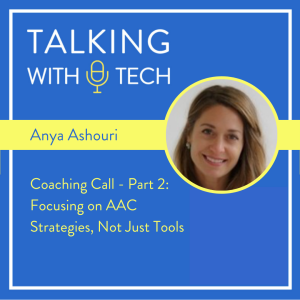
Wednesday Oct 20, 2021
Wednesday Oct 20, 2021
This week, the TWT team presents Part 2 of Chris and Rachel’s coaching call with Anya Ashouri, an SLP and AT Specialist for a Non-Public School. In this half of the coaching call, Chris, Rachel, and Anya discuss how to decide what the next AT strategy to work on with students will be, the benefits of providing visual supports to everyone all over the school, how to monitor the quality of implementation in the classroom, and how to get students more excited about the writing and editing process.
Before the interview, Chris and Rachel discuss a question from Luke about supporting AAC users who primarily use text to communicate (rather than symbols). Rachel touches on how to model AAC using text, when a typing-only system (e.g. Proloquo4Text) would be more appropriate than symbols + text, and how to encourage modeling AAC for a family when parents understand the child’s speech but it is difficult for others to understand.
🔑 When you are assessing a child with complex communication needs who has strengths in the area of writing, look at the complexity of the AAC user’s utterances - if there is low MLU and simplistic sentences, consider including symbols along with the keyboard to support language growth and modeling.
🔑 If a child wants to type messages more than use symbols, but they still have growth to make in learning vocabulary, consider a hybrid like TouchChat with WordPower80 that includes a keyboard and symbols. That will allow you to teach new vocabulary while using a keyboard at the same time.
🔑 When you are considering what kinds of supports you want to target on in the area of AT, consider the strategies that will make the biggest difference, and not just the tools that are needed. For example, making “modeling” a targeted strategy rather than making “high tech AAC” a target allows you to implement a strategy that can be used by all students, not just AAC users.
To listen to last week’s episode, visit talkingwithtech.org/episodes/anya-ashouri
Help us develop new content and keep the podcast going strong! Support our podcast at patreon.com/talkingwithtech!
Visit talkingwithtech.org to access previous episodes, resources, and CEU credits that you can earn for listening to TWT episodes!
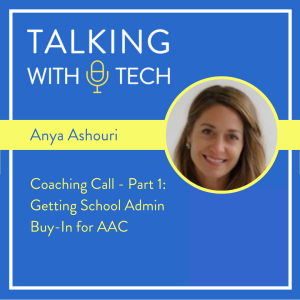
Thursday Oct 14, 2021
Thursday Oct 14, 2021
This week, the TWT team interviews Anya Ashouri, an SLP and AT Specialist for a Non-Public School who had questions about identifying students in her school who are complex communicators but were not given AAC to communicate. Anya describes how she came to learn that her school needed more robust AT, the steps she took to train herself on AAC and AT, and asks Chris and Rachel for advice on getting admin and parent buy-in for robust AAC.
Before the interview, Chris and Rachel talk about a journal article from May 2020, called “The Effects of Telepractice to Support Family Members in Modeling a Speech-Generating Device in the Home”. The article resonated with Chris and Rachel because they both had always felt that coaching family members through tele practice can lead to greater success than direct therapy alone.
Key ideas this week:
🔑 If we are building from the ground up, we should tell people what AAC is and why its important. It’s easy to overwhelm people with jargoin if they are not familiar with AAC.
🔑 Many people thing about the SETT framework to select the AT tool, but that is only one part of it. As you are having this discussion, discuss what kind of outcome you want? What else needs to change in the environment? Do we need to change the tasks?
🔑 When you visit a classroom, be conscious of how you can help all the kids, not just one student. Helping teachers with ways they can promote language development for all students is a good way to build rapport and buy-in.
Links:
“The Effects of Telepractice to Support Family Members in Modeling a Speech-Generating Device in the Home”. by Sarah Douglas, Elizabeth Biggs, Hedda Meadan, and Atikah Bagawan
https://pubs.asha.org/doi/10.1044/2021_AJSLP-20-00230
Help us develop new content and keep the podcast going strong! Support our podcast at patreon.com/talkingwithtech!
To listen to this episode, search "Talking with Tech" in your podcast player of choice or go to www.talkingwithtech.org/episodes/anya-ashouri
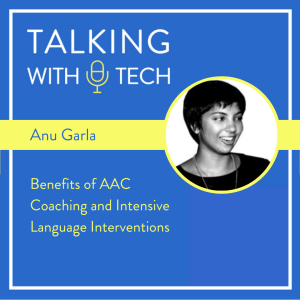
Wednesday Oct 06, 2021
Wednesday Oct 06, 2021
This week, Rachel interviews Anu Garla, a mother of Oliver, a boy with autism and cortical visual impairment who uses AAC to communicate. Anu describes her journey getting a diagnosis, how she started working with Rachel, why coaching with Rachel really jump started progress for her son, and advice that she has for other parents who are starting on an AAC journey (e.g. little “homework” assignments for parents can help).
Before the interview, Chris and Rachel discuss a recent presentation that Rachel did that she almost missed due to clerical error from one of her staff, and how she adjusted to the situation and made the presentation work. They also discuss how they decide how much to charge (or if to charge) for doing presentations, and have advice for people wanting to do more presentations.
Key Ideas This Week:
🔑 Oliver didn't really make a lot of progress until they started working more closely with Rachel during the pandemic. There was an intensive intervention with Rachel and Oliver that led to the discovery that the team needed to give more time for Oliver to initiate.
🔑 Sometimes, intervention in the home environment is more “quality than quantity”. If you have short, high quality interactions and connections with your child, they are still making progress. It doesn’t need to be hours of intense “drill and kill”, it can be based on brief, quality interactions throughout the day.
🔑 Its important to listen to families as much as other professionals on the team of an AAC user. Parents usually know their child better than anyone!
🔑 Before we decide if a child can or cannot do something, we need to make sure motivation is there. Motivation is a current that flows through everything we do as educators and therapists.
Help us develop new content and keep the podcast going strong! Support our podcast at patreon.com/talkingwithtech!
Visit talkingwithtech.org to access previous episodes, resources, and CEU credits that you can earn for listening to TWT episodes!
Link from this episode:
Comprehensive Literacy for All by Karen Erickson and David Koppenhaver: https://www.amazon.com/Comprehensive-Literacy-All-Significant-Disabilities/dp/1598576577
Anu's Facebook & Instagram: @oliphantabulousstormilicious
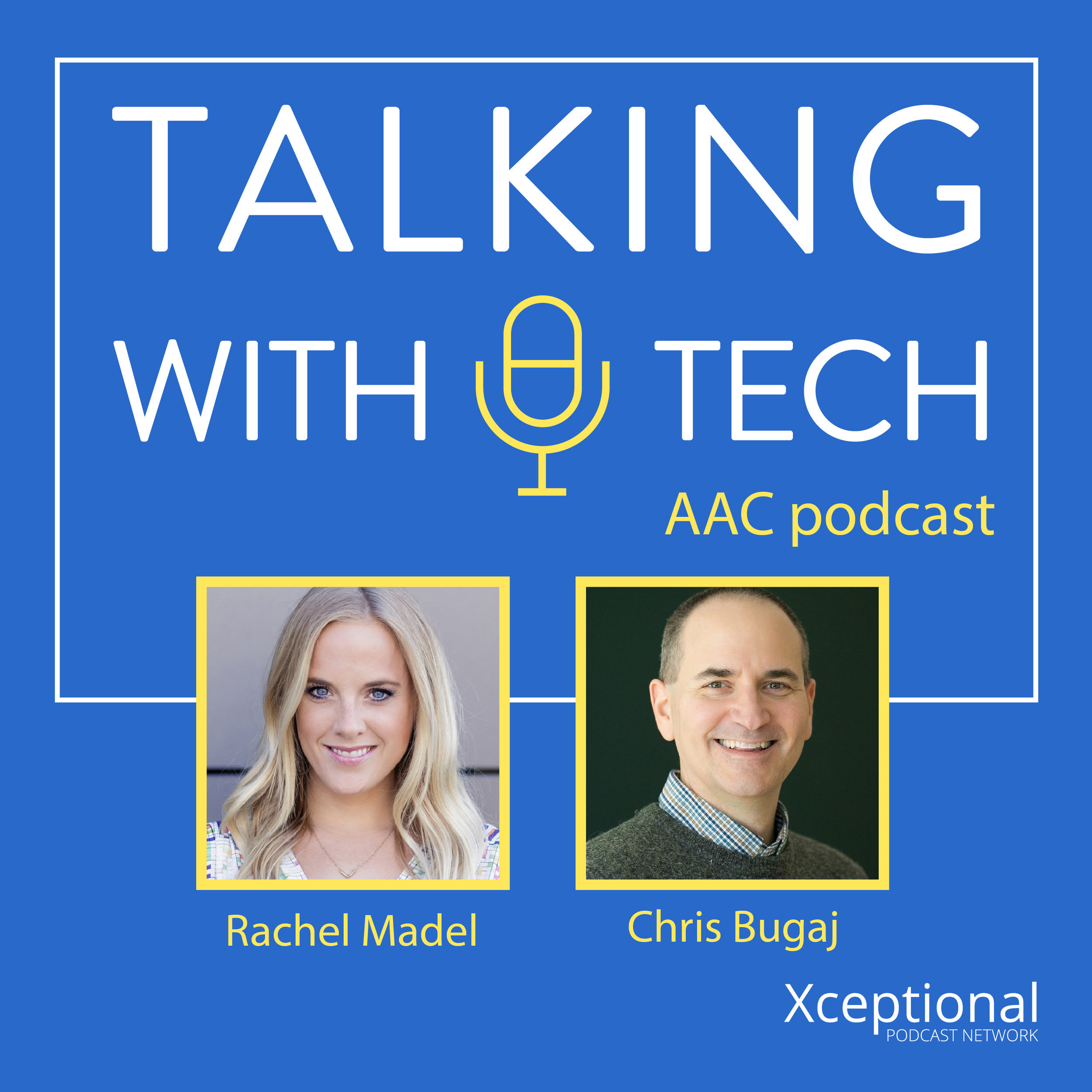
Join AAC experts Rachel Madel and Chris Bugaj as they dive into a weekly discussion about all things AAC (Augmentative and Alternative Communication). Every episode they deliver practical resources, clinical guidelines and relevant research to help clinicians better utilize technology for individuals with complex communication needs.
Episodes include interviews with industry thought-leaders, clinicians, parents, researchers and app developers to keep you on the pulse of the educational technology scene and better support communication through the use of technology.


